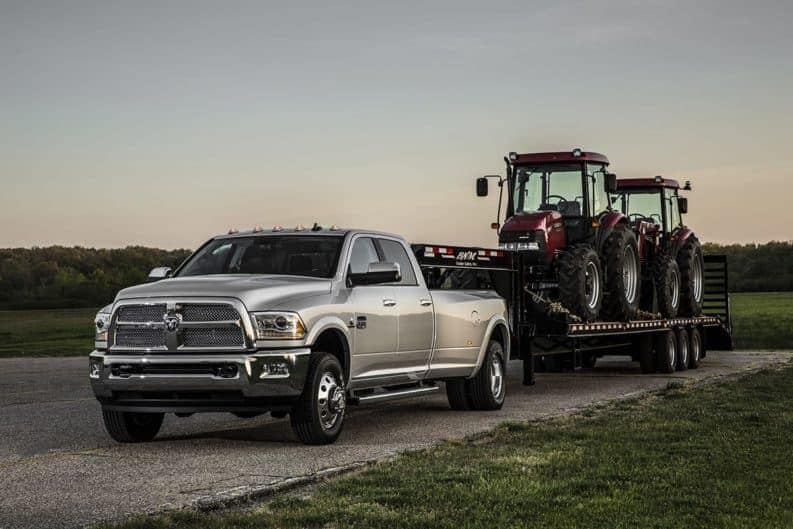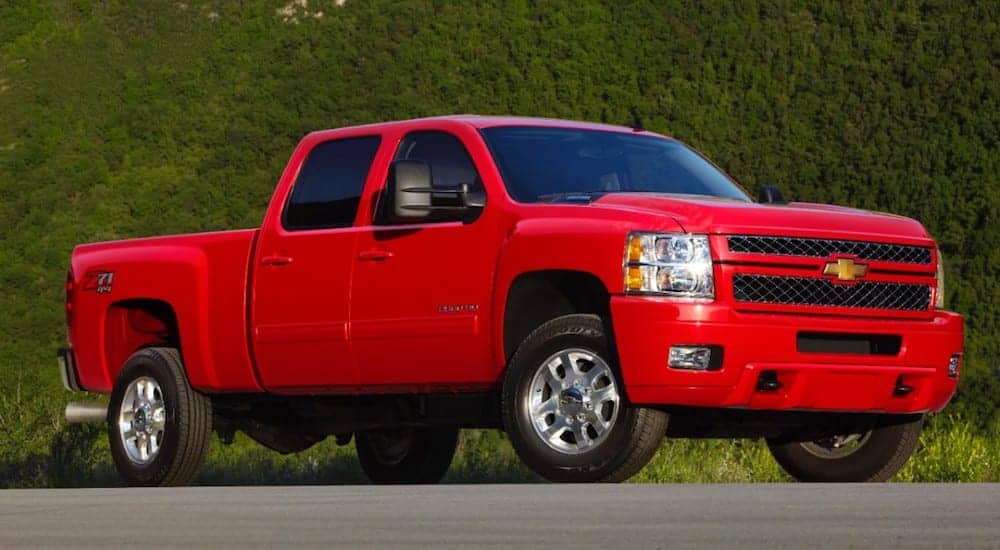The amount of times I’ve seen or heard people use payload and towing capacity interchangeably is mind-boggling. Heck, even when I first started learning truck-talk, I didn’t give a second thought when swapping the words around. But, they mean two completely different things, and if you think they mean the same thing, then you risk harming your truck. While both payload and towing capacity are based on a truck’s Gross Vehicle Weight Rating (GVWR – we’ll talk about that in a moment) and the strength of the frame, they aren’t even remotely similar. The best way to distinguish between the two is payload concerns carrying, and towing capacity means pulling. Why is this distinction so significant? You’ll see in a moment. But first, let’s start off by discussing what each of these terms actually means and how they are determined. Yes, this is going to be educational, but we’re talking about pickup trucks here so it can’t be too dull – plus this can save you a lot of money in the long run.
Payload
The payload is considered any of the extra stuff you put inside your vehicle. Whether that means passengers or 2,000 lbs. of drywall, it’s all the same. Even a 20-pound weight in the back seat would be considered part of the payload. Why? Because, payload is identified as what the vehicle can carry for weight, and is typically less than what a vehicle can tow.
How is payload determined? It’s based on the GVWR of a vehicle. The GVWR is the absolute total weight that a truck can handle, which includes the weight of the truck itself, based on its chassis and the materials it is made from. To figure out the payload of a truck, just find out its GVWR, then subtract the weight of the truck itself, and the amount you are left with is the payload. Seems pretty simple? Well, that’s because it is. But let’s take a look at what these numbers actually mean and what you can expect to see when looking at trucks on the market.
For the sake of example, let’s have a look at three different models of Chevy trucks: the 2019 Chevy Colorado, the 2019 Chevy Silverado 2500HD, and the 2019 Chevy Silverado 3500HD. These are basically the small, lightweight offering from Chevy and the two heavy-duty models that they offer. With these three examples, you get a pretty good sense of what’s available on the market and why certain trucks are advertised as “heavy duty” models compared to others.
The 2019 Chevy Colorado has a maximum payload of 1,574 lbs. This doesn’t change based on the size of the cab, but it can change depending on what engine you choose. Since different engines have different weights, a larger engine can increase the weight of the truck itself – but the frame of the truck doesn’t change, so its GVWR stays the same. The Chevy Colorado has a GVWR of 6,000 lbs. The weight of the truck can be 4,426 lbs. or 4,900 lbs. depending on what trim level you choose. So that makes its maximum payload 1,574 lbs. or 1,100 lbs. if you choose a heavier trim.
By comparison, the 2019 Chevy Silverado 2500HD has a maximum payload of 3,276 lbs. You can see that’s more than double what the Colorado can handle, which is why (in part) this is categorized as a heavy-duty truck. The Frame of the Silverado 2500HD is designed to support much more weight than the Colorado can, including weight from passengers and anything you put in the truck bed. Again, the cab choice doesn’t affect this, but the engine will.
Then there’s the 2019 Chevy Silverado 3500HD, which is the strongest pickup truck produced by Chevy for the consumer market. It is designed to be even stronger, with a frame that can handle even more weight. As such, it has a maximum payload of up to 6,112 lbs. That’s almost double the 2500HD, and nearly four times the payload capacity of the Chevy Colorado. Again, things like engine upgrades can impact this, as can anything else that affects the weight of the truck itself, like accessories and other options.
Towing Capacity
Towing capacity is a little easier to remember and is defined as pulling a trailer or anything else behind a vehicle. It’s literally that simple. The type of hitch can make a difference, which is why you will sometimes see trucks listed with both traditional towing capacity and gooseneck capacity. A gooseneck hitch can increase the towing capacity of the truck, especially if it is designed for getting more work done – but this can vary from one model to another.
Because the weight isn’t directly on the truck, towing is more dependent on the strength of the frame, torque of the engine, and the transmission. The advantage of this is a truck is able to pull a lot more than it’s able to carry. This also means that upgrading the engine to a more powerful and heavier model and adding a towing package, tends to increase the towing capacity of the truck, whereas these kinds of features reduce the payload since they increase the weight of the truck itself.
Let’s look at the same examples as before and see how different models give you different degrees of towing capacity – sometimes also referred to as “trailering.” Keep in mind that in these examples, a trailer or camper that you use is part of the total capacity. So if you have a trailer that already weighs 500 lbs. then that is included in the total capacity the truck can haul behind it.
The 2019 Chevy Colorado has a maximum towing capacity of 7,700 lbs. With this type of truck, the type of hitch you use probably doesn’t make a difference because it’s not really designed with a strong focus on hauling weight behind you. Still, 7,700 lbs. gives you a lot of freedom for towing a trailer or camper behind you. In order to get this maximum value, however, it is important to choose an engine with a focus on torque and any available trailering or towing package.
By comparison, the 2019 Chevy Silverado 2500HD has a maximum towing capacity of 14,500 lbs. So you can see that’s almost double the maximum towing that the Colorado has to offer, again this is why this type of truck is referred to as “heavy duty” in most markets. The frame of the truck, its engine, and other features have all been designed to optimize just how much weight it can pull behind it. Though there’s even better out there…
For example, the 2019 Chevy Silverado 3500HD, the most powerful consumer truck that Chevy makes, has a maximum trailering capacity of 20,000 lbs. That’s nearly three times greater than the Colorado, and a pretty good upgrade from even the 2500HD. Of course, you need to choose the right engine to get these kinds of numbers. Here’s what I mean: let’s look at, more or less, the same version of the 3500HD but with two different engines.
In both cases, we’re looking at the potential of a 4WD with a crew cab and long box. One of them has a 6.0L V8 engine that offers up to 380hp and 380 lb.-ft. of torque. The other has a 6.6L Turbo-Diesel V8 engine that offers up to 445hp and 910 lb.-ft. of torque – notice the huge difference in torque there?
You might wonder how much difference that actually makes. Well, the first one has a maximum towing capacity of 8,900 lbs. while the second engine gives you a maximum towing capacity of 15,000 lbs. That’s the difference a powerful engine with a lot of torque makes.
Confusion Risks Harm to Your Truck
So, what’s the point of all this information? Well, for one thing, you should know what these numbers mean as you look at different models, particularly when you’re in the market for a new truck. I mean, knowledge for its own sake is always a good thing – the more informed you are, the better you can make a choice and pick the right truck for what you need. But let’s go beyond that…
Say I want to buy a truck, and I don’t know the difference between payload and towing capacity. I like the look of the 2019 Chevy Colorado, and I see it has a maximum towing capacity of over 7,000 lbs. Terrific! That’s the truck for me. I buy this beauty, drive off the lot, head to my local lumber supply store, and pile 5,000 lbs. of wood into the bed of the truck. That sound I hear? That’s the frame straining and cracking, then the rear axle shattering under the extreme weight of all that wood.
Remember, the 2019 Chevy Colorado has a maximum payload of just 1,574 lbs. But if I don’t understand what those two numbers mean, then I’m more likely to make a serious, and costly, mistake. If I know I routinely pile 3,000 lbs. of materials into the bed of my truck, then I know I need to pick something like the 3500HD, which can handle all that weight.
There you have it. Now you know not to interchange the two terms willy-nilly, and you understand the repercussions if you do. Keep your definitions straight and you’ll be one critical step closer to living a happy and healthy pickup truck lifestyle.



